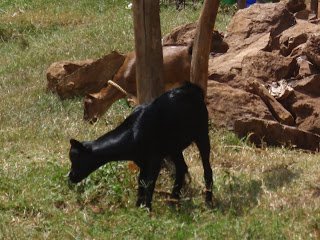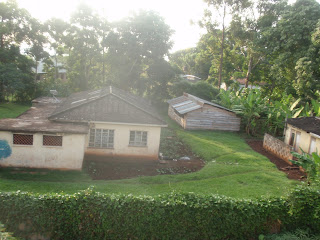
The simple, agrarian lifestyle achieved by most Ugandans holds great appeal for me. I'm not sure why, but perhaps the fact that I was raised on goat’s milk has something to do with it. American families average 2.4 televisions per household, while Ugandan families very likely average as many goats, and perhaps twice as many chickens.

I can’t help but wonder if we are the unfortunate ones in this equation, but that is a topic for another day.
One of the first differences you will note in Ugandan vs. American culture is the amount of time spent outdoors. I typically see my neighbors only in summer, and then only when they are working in their yards or out for a walk. Ugandans garden, work, visit,

...cook and even do dishes outside.

The primary means of transportation in Uganda is walking; streets and roads are lined with pedestrians of both the two and four footed variety. You will rarely see a Ugandan walking a dog, however. Their companions will most likely be goats, cows, or even pigs.

Homes come in many shapes, sizes, and varieties, the most common being a round hut.

Some of these huts are large enough for separate rooms inside, others are barely large enough for all the inhabitants to bed down at night.
We had the opportunity to visit several homes on this trip. One that I had greatly anticipated visiting was the home of ten adolescent girls.



Last fall, due to a generous donation to Heart of God International, I had the privilege of working with Pastor Ruth of Smile Africa to find housing and more appropriate schooling for these girls who formerly lived on the streets. The girls were so excited to invite us in and show us their home –a two bedroom apartment. They were especially proud of their own artwork that graced the walls.

I was pleased to see that the apartment is safe and secure and located very near Smile Africa.

The girls raise their own vegetables and are very self-sufficient. The youngest of these girls is 11, and the oldest 16! It is impossible to express here the love and admiration I have in my heart for these beautiful young ladies.
While in Tororo we were invited into Pastor Ruth’s home for a delicious meal.


She lives in an attractive, comfortable, and modest home with her husband and their three children who remain there.

Five of their children will be attending University this year, and one is working and living in Kampala. Pastor Ruth gives God all the glory for providing for herself and her family. She is tireless in her ministry to the widows and orphans of her city and surrounding area.
Agnes once again prepared a large, delicious meal for our entire group at her home in Entebbe.

She is the headmaster of Entebbe Early Learning Center, and her husband is a doctor. Their home is large, and their property nicely landscaped and gated. Still, she lives humbly and takes in many who are homeless. She is currently caring for an eighteen month old girl abandoned by her mother,

and two sisters who are refugees from Rwanda, trying to work their way through college.

Saphan and Alex, who run a prison ministry and graciously took care of our needs in Entebbe, invited us into their home for an afternoon visit just before we continued on to the airport for our departure. We took turns sitting in their small living room where we chatted and snacked on jackfruit.

The neighbors and their chickens all gathered around to greet us, too.
We observed several other homes from a distance.
The one located next to the hotel just below our deck was often bustling with activity,

and the resident rooster awoke us each morning.

Here are some other homes I observed as we traveled throughout Uganda.




I can say without qualification that Ugandans are hospitable people. They often give visitors what they can’t afford for themselves. Comfortable seating and beverages are offered at the very least, and one only needs to mention something they would like to try and it will most likely be promptly presented.
One such example occurred when Pastor Steven and his wife, Rozelyn, were serving our group of six a meal after church. I had seen many of the children chewing on sugar cane, so I mentioned that I had never tried sugar cane. Pastor Steven called for a church member to come in and then sent him out to “cut, clean, and properly prepare some sugar cane” for us. Several minutes later the man reappeared with a large bowl of sugar cane.

I have to say it was delectable, albeit somewhat challenging to eat! And, as we got in the van to leave, they tied a large bundle of sugar cane on top for us to share with everyone back at the hotel. Besides food, we were often treated to music and dancing –not so much in homes, but in nearly every school, church, and meeting place. How delightful!
Toilets are a luxury in Uganda, and flushing toilets a rarity. We were fortunate to have them at the hotels where we stayed, but we encountered “squattie potties” in most other locations. This was by far the nicest, cleanest squattie potty I encountered!

Running water is also a luxury, and not always reliable even when it is available –much like the electricity. It comes and goes; surges, and wanes. Ugandans take it all in stride. In fact, most don’t even notice because they aren’t dependent on it. Water is drawn from wells and carried home in 5-gallon containers -on a bicycle if a family is fortunate enough to have one,

...on top of the head if they are not as fortunate.

Ugandan homes are airy. There are no screens on the windows, and the light curtains that grace them dance in the breeze until tied in a knot. As I mentioned, most of the cooking is done outside in the open air, keeping the heat out of the house, or in a kitchen located outside the residence, like these deluxe kitchens at Entebbe Early Learning School

and Lubowa gardens and cottages.

Cooking charcoal is therefore a staple for every household.
A garden is a must for every residence as well, since rice and vegetables comprise most of the Ugandan diet.

Gardens come in all shapes and sizes, too, just like Ugandan homes. This one is a bag garden, popular for the small space and amount of water and labor required to maintain it.

So, of course, home is where you tie your goats

–to keep them out of the garden.
I have learned a lot from observing the way that Ugandan's live. They work hard and live close to the earth, depending on it and what God provides through it for their daily sustenance. Even wealthy Ugandans live simply by American standards. Still, those who love Jesus are always willing to open the doors of their unassuming homes and share what they have with others. Isn't that exactly what God would ask of each of us, regardless of our culture or our resources?
I hope you return soon for my next blog installment, “Pass the Posho, Please.”





Sharlyn,
ReplyDeleteTruly is amazes me and makes me thankful for what I have in seeing how thankful these people are for what they have. They could teach us all a lesson in contentment.
Praying for you and for God's blessing to shine upon you all.
Love and Hugs ~ Kat
What a trip and the memories that will keep challenging you!
ReplyDeleteThanks again for sharing!
Sandy
Wow, what a journey! And the squattie potties in Cambodia were not my fav part for sure. Love hearing of the hospitality and praise you encountered.
ReplyDelete